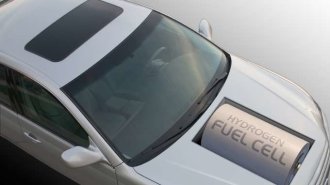
With environmental concerns a hot topic across the globe, vehicles powered by a hydrogen fuel system are the latest technology to hit our roads, and one that shows great promise for the future. Because they operate in a very different way from traditional internal combustion engines, there is a lot of confusion about how exactly they work and why they are so popular.
Unlike electric engines such as those found in the Prius Hybrid, which are powered by heavy rechargeable battery packs, a fuel cell vehicle generates its energy on the fly. Known officially as the polymer exchange membrane fuel cell, this version of fuel cell converts hydrogen and oxygen into water, generating electricity in the process.
A fuel cell is composed of four parts: an anode, cathode, proton exchange membrane (PEM), and catalyst. The proton exchange membrane is a material similar to plastic wrap, that is specially treated to only conduct positively charged ions. This layer forms the center of the fuel cell sandwich and is surrounded by a catalyst on each side. This catalyst is a carbon fabric coated on one side by a thin layer of tiny particles of platinum. The platinum coated side of each faces the PEM, while the other side is backed by an anode on one half, and a cathode on the other half of the fuel cell. Both the cathode and anode feature unique grooves designed to allow even dispersal of hydrogen and oxygen gas along their respective halves.
When a molecule of H2 comes in contact with this platinum layer, it splits into two positively charged Hydrogen ions and two negatively charged electrons. These electrons are conducted through the anode and directed to an external circuit, while in the cathode, O2 molecules are split into two oxygen atoms. Electrons from the hydrogen splitting process are conducted into the cathode from the external circuit after they have done their work, and from here the positively charged hydrogen recombines with the stray electrons and oxygen to form a water molecule.
While alternative fuels conversion processes such as those in a fuel cell create energy efficiently and without excessive waste products, they are not perfect. Because of the precise components inside a fuel cell, and the precious metals contained therein, cost is a major limiting factor. Durability is another concern, as stop and go driving tends to take a large toll on the components of the fuel cell.
Hydration is another concern, as while sufficient hydration is key to proper function, higher temperatures required due to impurities in fuel tend to deplete this hydration. Sub-zero operation and function in excessively low humidity is also currently impossible, making fuel cells promising, yet incredibly temperamental in their current state.
While still in its infancy from a technological perspective, the efficiency and lack of excessive waste in fuel cells are key points that make them a prime candidate for future use. While current problems limit their potential use in the real world, it may only be a matter of time until such technologies mature and begin finding their ways into every aspect of modern life.